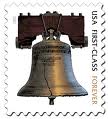The US Postal Service is seeking approval for a price increase on US stamps from 44 cents to 46 cents. If approved, the stamps would go up in price effective January 2nd, 2011. As an approval is likely, stamp arbitrage may be possible by buying stamps for $0.44 and selling for $0.46 after next January 2nd. However, because of the time difference, real return may be closer to zero. Nevertheless, it might work if one could buy at old price and sell at new price soon after (quick 5% return). Although the market for postage stamps doesn’t seem to be all that liquid, it seems completely legal to sell stamps at higher price than the US post office. In fact, third party sellers such as grocery stores or other retail stores often add a small charge to the price for a book of stamps.
Warren Buffet himself tried making money out of stamps during his early years, only to end in complete failure. In “Snowball”, Alice Schroeder writes:
The idea of postage stamp arbitrage is not new. Going further back in time, Charles Ponzi (for which “Ponzi scheme” is named after) had a similar idea, except his idea involved an illegal implementation network. His original idea is described below.
http://www.valuehuntr.com
Warren Buffet himself tried making money out of stamps during his early years, only to end in complete failure. In “Snowball”, Alice Schroeder writes:
With his friends, he (Buffett) invested $25,000 in 1957 on 4-cent Blue eagle stamps which the US government was ready to take out of circulation. By eliminating the supply, they ruined any chance of the stamps becoming valuable. His partners were still mailing him with Blue Eagle postage decades later.

The idea of postage stamp arbitrage is not new. Going further back in time, Charles Ponzi (for which “Ponzi scheme” is named after) had a similar idea, except his idea involved an illegal implementation network. His original idea is described below.
A few weeks later, Ponzi received a letter in the mail from a company in Spain asking about the catalog. Inside the envelope was an International reply coupon (IRC), something which he had never seen before. He asked about it and found a weakness in the system which would, in theory, allow him to make money. The purpose of the postal reply coupon was to allow someone in one country to send it to a correspondent in another country, who could use it to pay the postage of a reply. IRCs were priced at the cost of postage in the country of purchase, but could be exchanged for stamps to cover the cost of postage in the country where redeemed; if these values were different, there was a potential profit. Inflation after World War I had greatly decreased the cost of postage in Italy expressed in U.S. dollars, so that an IRC could be bought cheaply in Italy and exchanged for U.S. stamps of higher value, which could then be sold. Ponzi claimed that the net profit on these transactions, after expenses and exchange rates, was in excess of 400%. This was a form of arbitrage, or profiting by buying an asset at a lower price in one market and immediately selling it in a market where the price is higher.Valuehuntr
http://www.valuehuntr.com